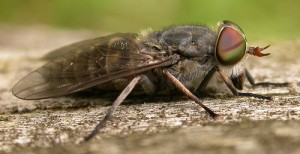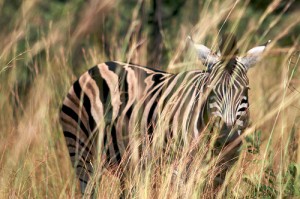Ever wonder why zebras have that distinctive black and white striped pattern? Scientist Gábor Horváth and his team have come up with a new explanation: Zebra’s stripes evolved to help ward off blood-sucking tabanids, more commonly known as horseflies.
Originally, scientists thought that zebras were white animals that developed black stripes over time. They thought this because the underbelly of the animal is white. However, it has been found that zebra embryos actually start out black and develop their white stripes during their gestational period. Horváth and his team hypothesized that zebras developed their white stripes to become less attractive to horseflies. Horseflies are attracted to horizontally polarized light. This is because these insects like to mate and lay their eggs in water, which polarizes light horizontally. Female horseflies, the ones that do the blood-sucking, are also attracted to the horizontally polarized light reflected from animals’ hides. Darker surfaces reflect horizontally polarized light; this explains why horseflies are more attracted to darker horses than they are to white ones.
The researchers conducted their study at a horse farm close to Budapest, which was heavily infested with horseflies. The team used models of horses with black and white striped patterns, which varied in the angle, density and width of the stripes. Also, they reflected different directions of polarized light off the models. Their prediction was that completely white models would have the least, dark models would have the most, and striped ones would have an intermediate amount of flies. Using oil and glue to trap the flies, it was found that the striped models actually attracted the least amount of flies.
Using their data that was collected, they found that the width of zebras’ stripes are positively correlated with the striped patterns that horseflies were least attracted to. It was also seen that narrower stripes were less attractive to horseflies. This led Horváth and his team to conclude that the zebra developed its striped pattern to ward off horseflies.
There could be other reasons why zebras evolved stripes. One reason may have been to camouflage into tall grass, as most of the zebra’s predators are colour blind. It is possible that the stripes may have evolved to confuse predators, making it hard to focus on one zebra at a time. Another reason may have been for reproduction, with the stripes being a way for the animals to tell each other apart and choose mates.
It is likely that the evolution of the zebra’s stripes is a combination of many or all of these ideas, and there could also be other reasons. One thing is for sure, nature is fascinating, and it is amazing to know that it is very likely that zebras evolved stripes to act as a natural insect repellent. I may test this theory myself; you might see me wearing stripes next time I’m hiking through the woods!
References:
http://www.sciencedaily.com/releases/2012/02/120209101730.htm
http://jeb.biologists.org/content/215/5/iii
http://earthsky.org/biodiversity/how-zebras-got-their-stripes



